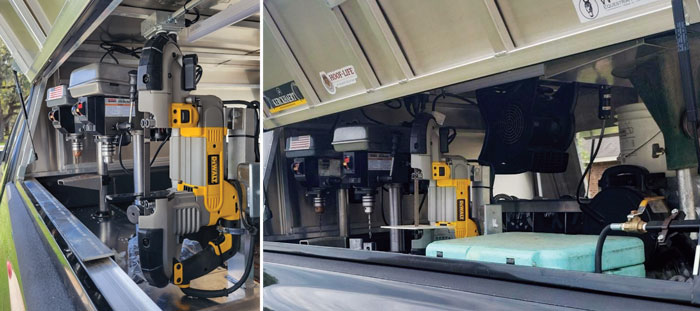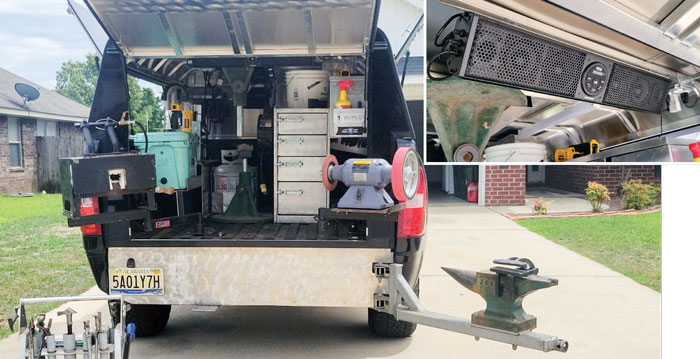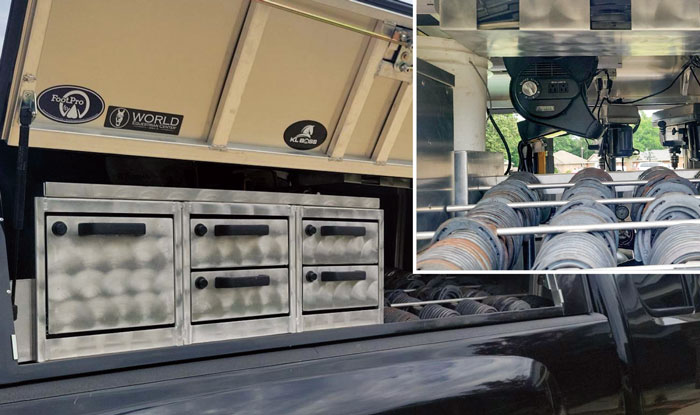The prices of a decent rig can be overwhelming when you’re straight out of farrier school. Often, there are bills and expenses to be paid toward school, equipment, supplies and other needs. However, when a new rig comes into the picture, the expenses can become difficult to manage. These numbers aren’t feasible for most students just getting out of farrier school and make it hard for them to feel that they can succeed within the industry. Knowing how to plan, budget and build for the future can help up-and-coming farriers make it in the farrier industry, and build the perfect, budget-friendly rig to assist them in their day-to-day jobs.
Feeling discouraged by the prices of rigs, Tyler Jones from Daphne, Ala., created a startup budget-friendly rig. Right out of farrier school, he started noticing the prices for high-end farrier rigs.
Takeaways
- A farrier doesn’t need to break the bank to have an efficient mobile work station to perform hoof care. A well-designed enclosed truck bed works well while you establish your practice.
- Consult your mentor, farriers and manufacturers to design a rig that fits your needs.
“I remember getting in the truck with Lane McNew in Gadsden, Ala., and heading down the mountain with a fully loaded aluminum trailer behind us,” Jones says. “I remember thinking I’ll never make it to this level of success. I don’t have the money to do this.”
He realized, however, that you don’t necessarily need a lot of money to make your farrier dream come true.
Jones wanted to follow his ambitions as a farrier without breaking the bank. He knew that he needed a decent rig to do well in the industry, so he started crafting his ideas for a budget-friendly rig. Jones’ ambitions led to far more.
“I had an idea in my head of what I wanted my rig to be and how I wanted it to function,” he says, “but the ideas on paper versus what will actually work can be quite different.”
Growing up, he worked in fabrication and welding and has always had an eye for this type of work. Jones began to pick apart the different aspects of various high-end rigs to make one of his very own.

The driver’s side of Jones’ truck includes a pair of drill presses, a Dewalt bandsaw (inset) and a cooler.
Knowing the prices of the pieces he would need to complete an efficient rig, Jones reached out to mentors Andy Gumpert and Neal Purdy at Finger Lakes Manufacturing in Ocala, Fla., who took the initiative to help. They put it all together one piece at a time. This made it possible to stick to a budget and still obtain everything he would eventually need as a farrier. He installed various pieces of farrier equipment including an anvil, a forge double burner, a Baldor grinder, two drill presses, a welding machine and much more. He has also installed a cooler, fans, lights and a sound system. With great cost efficiency, he was even able to afford various custom pieces for his rig, whereas a rig on the market would have cost exponentially more than he could have afforded straight out of farrier school.
Jones’ rig is now fully operational after only 3 months of building it. Initially, he planned to upgrade after a few years. However, now that he has built the rig, he plans to continue with this one for a while longer. Jones managed to make the rig his very own by adding his sense of style and personality. Everything is designed for his comfort and flair. Much like when he is shoeing, Jones likes to have his personality shine through. The same can be said for his budget-friendly farrier rig.

Jones created an efficient shoeing rig that features a swing-out anvil, forge and grinder; storage for equipment such as his hoof stand, propane bottle and fly spray. It also includes storage drawers with special latches that prevent them from opening during transport. The rig even has a stereo installed in the ceiling (inset).
Jones now uses his new rig to perform and make shoe repairs for a variety of horses. He can clean, trim and shoe hooves for horses participating in jumping events, dressage and rodeo. With all of his equipment easily within reach, he can be sure that he can properly and efficiently do his job.
“If your mentors see you trying to succeed, they want to be part of that…”
A farrier’s knowledge and skills are especially important to owners and horses when there is an injury. The horse owners need the farriers, and their equipment, to quickly help or heal their horses’ hooves. When a farrier does not have the proper equipment or rig to do so it could result in the injury of the farrier, owner, or horse and the loss of the competition or sport that is being participated in.
Having the “Want” to Succeed
Jones mentions the importance of having the “want to succeed, and going against the norms.” When he first graduated from Lookout Mountain School of Horseshoeing in Gadsden, Ala., he did not see his goals and ambitions coming true due to the expensive prices. However, after taking the initiative to make them happen, he realized that was not the case.

The passenger side of Jones’ truck features a storage box (left), a horseshoe rack (inset) and pad storage above the shoe rack. A fan is in the ceiling.
“You need ‘want to,’” he says. “If your mentors see you trying to succeed, they want to be a part of that.”
With a few mentors, a budget and the “want” to be a farrier, Jones was able to completely design his very own rig to pursue his goals and ambitions. The rig has helped him in his career as a farrier and Jones is hopeful it will continue to help him provide great horsemanship.
This rig may even be an option for other up-and-coming farriers straight out of school, or sticking to a budget. Jones hopes that his budget-friendly rig will inspire others, and help them to continue their farrier journey.
LEARN MORE ONLINE …
Gain more insight on other “Badass Rigs & Trailers” by visiting this link.









Post a comment
Report Abusive Comment